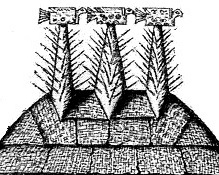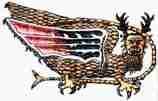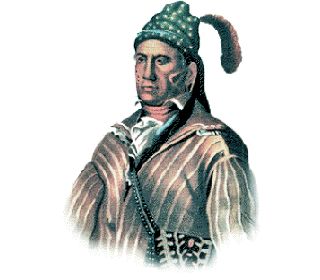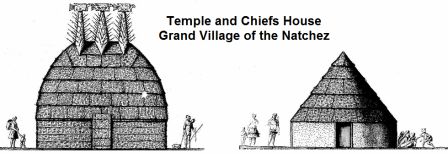The Great Village of the Natchez
The Grand Village of the Natchez was organized around an open plaza with two eight feet high, flat-topped mounds at either end. On one mound was the residence of the Great Sun, and on the other mound was the Sun Temple, containing the perpetual fire and a platform with the bones of the previous Great Sun. The structures had no windows and only one door which faced east in the direction of the rising sun. Other houses in the Natchez village were built in a similar fashion, but were not constructed on the top of mounds. The Serpent
The painted symbols displayed on the top of the Natchez Sun temple are very similar to the mythical beings called the Piasa and the Great Serpent that featured strongly in the Mississippian culture. 


The Natchez temple was used for elaborate funeral rituals, human sacrifice including the ritual suicides. The people believed that the Underworld was inhabited by spirit snakes or serpents and that the Upper world was inhabited by spirit birds and the people of the earth who were ruled by powerful spirits like the Piasa and the Serpent. What language did the Natchez tribe speak?
The tribe spoke in Natchez, the ancient language of the people, distantly related to the Muskogean languages. What did the Natchez tribe eat?
The food that the Natchez tribe ate were based on the crops they farmed of corns, beans and squash. They also hunted for meat and fish gathered wild plant foods. Food was cooked into soups, bread, cornbread and hominy. The people also grew a grain-bearing grass and tobacco. They obtained salt from Caddo tribes to the northwest. What weapons did the Natchez use?
The weapons used by the Natchez included war clubs, maces, knives, bows and arrows, pikes, axes, and they sometimes carried shields. Ancient Natchez Clothing
The clothes of the Natchez men were limited to breechcloths made from mulberry tree inner bark fabric and/or deerskin. The women wore a knee-length skirt, also made from a bark fabric. The children went naked until the age of about ten years. Both Natchez men and women painted their faces for special occasions and also decorated their bodies with tattoos. The Natchez chiefs and nobles wore beautiful feather cloaks or mantles of parakeet, crane, turkey, woodpecker, hawk, eagle, swan or duck feathers. The feathers overlapped each other and were attached to a net made from the roots of nettles, silk grass or mulberry bark fibers. For special ceremonies these feather cloaks reached ankle length. The Great Sun wore a magnificent crown of red tasselled swan feathers, the Natchez nobles also wore distinctive feather headdresses. Natchez Clothing: European Influence on Southeastern Native Indians
The Natchez Native Indians began to change their style of dress soon after their first encounters with Europeans, as can be seen by the picture of the Natchez Native Indian at the top of the page. During the 1800's cloth became even more readily available. They used strips of cloth, such as wool, calico or even silk, wrapped around their head like a turban. The turban style headdress was often decorated with a feather plume which were considered to be of spiritual significance and held great power. The next favored item of clothing of the Natchez was an outer garment called a matchcoat. A matchcoat was basically a blanket that was fastened around the body, often fastened around the waist with a sash. Sometimes matchcoats were hung over their shoulders or in warm weather just fastened around the middle. In cold weather matchcoats could be arranged to cover the head. Natchez History: What happened to the Natchez tribe?
The following Natchez history timeline details facts, dates and famous landmarks of the people. The Natchez timeline explains what happened to the people of their tribe following the arrival of the Europeans. Natchez History Timeline 1542: The Hernando De Soto expedition encounters the Quigualtam, famed for the Winterville Mounds, believed to be the ancestors of the Natchez. Fierce fighting drove the Europeans away but they brought diseases such as smallpox and measles to the people 1650: The Natchez population was about 5,000 to 4,500 in 1650 and 300 in 1731. 1682: Rene-Robert Cavelier, Sieur de La Salle makes the first recorded contact with the Natchez Native Indians 1713: The French establish a colony and trading posts on Natchez land 1716: Fort Rosalie was established by the French 1716 and was held successively by France, Great Britain, Spain, and the United States 1716: First Natchez War. Further conflicts erupt with the French in 1722 and 1729 1718: European colonists negotiated land deals for large plantations 1729: Nachez Revolt (1729 - 1731) The French force 400 Natchez to surrender 1729: The French kill some of the Natchez captives and send others to Santo Domingo as slaves 1729: Their social system collapsed and Natchez survivors joined the Creek, Catawba, Cherokee, Chickasaw and Seminole tribes 1730: The French and the Choctaw joined forces against the Natchez 1733: The French captured the Great Sun, several of the War Chiefs and over four hundred of the Natchez tribe, who were sent from New Orleans to St. Domingo as slaves 1735: Some Natchez refugees settled with the Chickasaws and Creeks, others fled to Tallahassee Creek, an affluent of Coosa River in South Carolina 1755: The Waccamaw tribe waged war with Cherokee and Natchez 1830: The Indian Removal Act of 1830 1831: The Choctaw is the first of the tribes to march 1000 miles to Oklahoma on the 'Trail of Tears' 1832: The Natchez tribe, with other tribes of the Five Civilised Tribes, are forcibly located to Indian Territory. They lose their identity as they are assimilated into the other tribes 1832: The Seminole were removed 1834: The Creek were removed 1837: The Chickasaw were removed 1838: The Cherokee were removed 1887: The Dawes Act 1893, President Grover Cleveland appoints Senator Henry L. Dawes, to negotiate land with the Cherokee, Creek, Choctaw, Chickasaw and Seminole tribes 1893: The Dawes Rolls, or the Final Rolls of the Five Civilized Tribes, entitled an allotment of land to tribe members, in return for abolishing their governments and recognizing Federal laws 1934: The individual allotment policy of the Dawes Act was terminated by the Indian Reorganization Act
Natchez settlements are now in the southern half of the Mvskoke reservation and the west central part of the Cherokee reservation in Oklahoma. Two Natchez communities are also recognized by the state of South Carolina. Natchez History Timeline |




